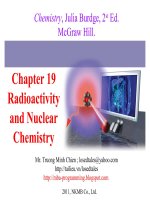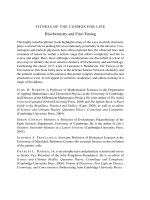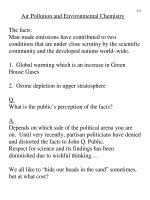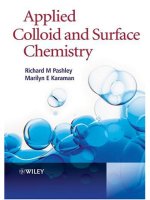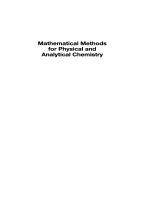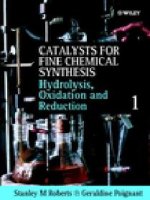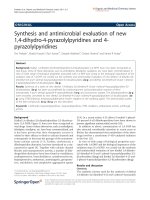Ruthenium catalysts and fine chemistry
Bạn đang xem bản rút gọn của tài liệu. Xem và tải ngay bản đầy đủ của tài liệu tại đây (6.38 MB, 335 trang )
Volume Editors
Dr. Christian Bruneau
UMR 6509
Université de Rennes 1
(Campus de Beaulieu)
35042 Rennes Cedex
France
Professor Pierre H. Dixneuf
Institut de Chimie de Rennes
Université de Rennes 1
(Campus de Beaulieu)
35042 Rennes Cedex
France
Editorial Board
Dr. John M. Brown
Prof. Pierre H. Dixneuf
Dyson Perrins Laboratory
South Parks Road
Oxford OX1 3QY
Campus de Beaulieu
Université de Rennes 1
Av. du Gl Leclerc
35042 Rennes Cedex, France
Prof. Alois Fürstner
Prof. Louis S. Hegedus
Max-Planck-Institut für Kohlenforschung
Kaiser-Wilhelm-Platz 1
45470 Mühlheim an der Ruhr, Germany
Department of Chemistry
Colorado State University
Fort Collins, Colorado 80523-1872, USA
hegedus@lamar. colostate.edu
Prof. Peter Hofmann
Prof. Paul Knochel
Organisch-Chemisches Institut
Universität Heidelberg
Im Neuenheimer Feld 270
69120 Heidelberg, Germany
Fachbereich Chemie
Ludwig-Maximilians-Universität
Butenandstr. 5–13
Gebäuse F
81377 München, Germany
Prof. Gerard van Koten
Prof. Shinji Murai
Department of Metal-Mediated Synthesis
Debye Research Institute
Utrecht University
Padualaan 8
3584 CA Utrecht, The Netherlands
Faculty of Engineering
Department of Applied Chemistry
Osaka University
Yamadaoka 2-1, Suita-shi
Osaka 565, Japan
Prof. Manfred Reetz
Max-Planck-Institut für Kohlenforschung
Kaiser-Wilhelm-Platz 1
45470 Mülheim an der Ruhr, Germany
Preface
During the last decade molecular ruthenium catalysts, have provided a variety
of novel activation processes leading to powerful new organic synthetic methods, that are not promoted by other metal catalysts. Ruthenium catalysis constitutes an emerging field for the selective preparation of fine chemicals. This
is due to the availability of a large number of well-defined and stable ruthenium precatalysts offering several possible oxidation states. They usually tolerate functional groups and have revealed catalytic activities for a wide range of
chemical transformations with atom economy. New ruthenium catalysts make
possible carbon–carbon, carbon–hydrogen, carbon–heteroatom bond formation and cleavage, and are able to provide non classical activation modes.
The most important discoveries in ruthenium catalysis are highlighted
and innovative activation processes, some of which are still controversial, are
presented in this volume. They illustrate the usefulness in organic synthesis
of specific reactions including carbocyclization, cyclopropanation, olefin metathesis, carbonylation, oxidation, transformation of silicon containing substrates, and show novel reactions operating via vinylidene intermediates,
radical processes, inert bonds activation as well as catalysis in water.
This monograph is not intended to provide a comprehensive view of all
ruthenium-catalyzed reactions, as it is an explosive growth field. For instance,
ruthenium-catalyzed enantioselective hydrogenation, already detailed in
several monographs, will not be treated here in spite of its high impact in
organic synthesis.
This volume should be helpful to researchers, teachers and students interested in innovative and sustainable chemistry. We are grateful to the experts
who have contributed by writing a chapter and we dedicate this volume to all
chemists and students who have been the actors in the first steps of this fast
developing field.
Rennes, France, March 2004
Christian Bruneau
Pierre H. Dixneuf
Preface
Contents
Ruthenium-Catalyzed C–C Bond Formation
S. Dérien · F. Monnier · P.H. Dixneuf . . . . . . . . . . . . . . . . . . . . .
1
Activation of Inert C–H Bonds
F. Kakiuchi · N. Chatani . . . . . . . . . . . . . . . . . . . . . . . . . . . . 45
Cyclopropanation with Ruthenium Catalysts
H. Nishiyama . . . . . . . . . . . . . . . . . . . . . . . . . . . . . . . . . 81
Recent Advances in Alkene Metathesis
S.J. Connon · S. Blechert . . . . . . . . . . . . . . . . . . . . . . . . . . . 93
Ruthenium Vinylidenes and Allenylidenes in Catalysis
C. Bruneau . . . . . . . . . . . . . . . . . . . . . . . . . . . . . . . . . . . 125
Ruthenium-Promoted Radical Processes Toward Fine Chemistry
L. Delaude · A. Demonceau · A.F. Noels . . . . . . . . . . . . . . . . . . . 155
Selective Carbonylations with Ruthenium Catalysts
N. Chatani . . . . . . . . . . . . . . . . . . . . . . . . . . . . . . . . . . . 173
Synthesis of Silicon Derivatives with Ruthenium Catalysts
B. Marciniec · C. Pretraszuk . . . . . . . . . . . . . . . . . . . . . . . . . 197
Ruthenium-Catalyzed Synthesis of Heterocyclic Compounds
Y. Yamamoto · K. Itoh . . . . . . . . . . . . . . . . . . . . . . . . . . . . . 249
Oxidations Using Ruthenium Catalysts
I.W.C.E. Arends · T. Kodama · R.A. Sheldon . . . . . . . . . . . . . . . . 277
Ruthenium-Catalyzed Organic Synthesis in Aqueous Media
M. Wang · C.-J. Li . . . . . . . . . . . . . . . . . . . . . . . . . . . . . . . 321
Author Index Volumes 1–7 and 11 . . . . . . . . . . . . . . . . . . . . . . 337
Subject Index . . . . . . . . . . . . . . . . . . . . . . . . . . . . . . . . . 343
Topics Organomet Chem (2004) 11: 1– 44
DOI 10.1007/b94642
© Springer-Verlag Berlin Heidelberg 2004
Ruthenium-Catalyzed C–C Bond Formation
Sylvie Dérien (✉) · Florian Monnier · Pierre H. Dixneuf
Institut de Chimie de Rennes, UMR 6509 Université de Rennes 1– CNRS, Organométalliques
et Catalyse, Campus de Beaulieu, 35042 Rennes, France
1
Introduction . . . . . . . . . . . . . . . . . . . . . . . . . . . . . . . . . . . .
2
2
2.1
2.2
2.3
2.4
Coupling Reactions of Two C=C Bonds .
Dimerization of Functional Alkenes . . .
Cross-Couplings of Alkenes . . . . . . . .
Cyclizations . . . . . . . . . . . . . . . . .
Carbonylations Involving Two C=C Bonds
.
.
.
.
.
3
3
4
5
6
3
Mixed C=C Bond and 1,3-Diene Coupling Reactions . . . . . . . . . . . . . .
3.1 New Diene Formation from 1,3-Dienes . . . . . . . . . . . . . . . . . . . . .
3.2 Diels–Alder and Ene Reactions . . . . . . . . . . . . . . . . . . . . . . . . . .
7
7
8
.
.
.
.
.
.
.
.
.
.
.
.
.
.
.
.
.
.
.
.
.
.
.
.
.
.
.
.
.
.
.
.
.
.
.
.
.
.
.
.
.
.
.
.
.
.
.
.
.
.
.
.
.
.
.
.
.
.
.
.
.
.
.
.
.
.
.
.
.
.
.
.
.
.
.
.
.
.
.
.
.
.
.
.
.
.
.
.
.
.
.
.
.
.
.
4
Cross-Coupling of 1,3-Diene
. . . . . . . . . . . . . . . . . . . . . . . . . . .
9
5
Cross-Coupling of a C=C Bond with Allene . . . . . . . . . . . . . . . . . . .
10
∫ C Bonds . . . . . . . . . . . . . . .
6
Coupling Reactions of C=C and C∫
6.1 Linear Intermolecular Couplings Involving Ruthenacycle Intermediates
6.2 Intermolecular Coupling Involving Hydrometallation
or C–H Bond Activation . . . . . . . . . . . . . . . . . . . . . . . . . . .
6.3 Intermolecular Coupling with Cycle Formation . . . . . . . . . . . . . .
6.4 Coupling of C=C and C∫C Bonds via Ruthenium Vinylidene Complexes
6.5 C=C and C∫C Bond Couplings Involving Heteroatom Additions . . . .
6.6 Enyne Cycloisomerization . . . . . . . . . . . . . . . . . . . . . . . . . .
. . .
. . .
12
12
.
.
.
.
.
.
.
.
.
.
15
16
18
19
21
. . . . . . . . . . . . . . . . . . .
26
∫ C/C∫
∫ C Bond Coupling . . . . . . . . . . . . . . . . . . . . . . . . . . . . .
8
C∫
8.1 Intermolecular Coupling of Alkynes . . . . . . . . . . . . . . . . . . . . . . .
8.2 Intramolecular Coupling of Diynes . . . . . . . . . . . . . . . . . . . . . . . .
27
27
30
9
Addition of Diazo Compounds . . . . . . . . . . . . . . . . . . . . . . . . . .
9.1 Addition to Alkenes . . . . . . . . . . . . . . . . . . . . . . . . . . . . . . . .
9.2 Addition to Alkynes . . . . . . . . . . . . . . . . . . . . . . . . . . . . . . . .
33
33
34
10
Allylic Alkylation Reaction . . . . . . . . . . . . . . . . . . . . . . . . . . . .
35
11
Propargylic Substitution Reactions
. . . . . . . . . . . . . . . . . . . . . . .
36
12
Reactions via C–H Bond Activation
. . . . . . . . . . . . . . . . . . . . . . .
37
7
∫ C Bonds and Dienes
Cross-Coupling of C∫
.
.
.
.
.
2
S. Dérien et al.
13
Reactions Involving Carbonylations Promoted by Ruthenium Complexes . .
38
14
Radical Reactions
. . . . . . . . . . . . . . . . . . . . . . . . . . . . . . . . .
39
15
Concluding Remarks
. . . . . . . . . . . . . . . . . . . . . . . . . . . . . . .
39
References . . . . . . . . . . . . . . . . . . . . . . . . . . . . . . . . . . . . . . . .
40
Abstract Molecular ruthenium catalysts are now currently used to perform selective carbon–carbon bond formation by combination of simple substrates. Their tolerance toward
functional groups has allowed the access to high value, multifunctional molecules. It will be
shown that ruthenium catalysts allow the coupling of functional alkenes or alkynes with a
variety of unsaturated molecules such as alkenes, dienes, alkynes, and diynes. A large range
of electron-rich ruthenium or hydridoruthenium complexes are currently used for the formation of cyclic and polycyclic compounds on reaction with substrates containing several
unsaturated C–C bonds. Ruthenium complexes have promoted several original activation
pathways, such as C–H bond activation, the distribution of carbene from diazoalkanes, and
especially their versatility in making a large variety of ruthenacycle intermediates. Besides
the applications of ruthenium precatalysts in organic synthesis an important discussion of
and mechanisms will be presented.
Keywords Ruthenium catalysts · C–C and C=C bond formation · Alkenes · Alkynes · Allyl
ruthenium · Ruthenacycle · Hydroruthenation
1
Introduction
During the last decade, molecular ruthenium catalysts have promoted tremendous developments in organic synthesis methodology and polymer science,
and revealed novel activation processes. Ruthenium catalysts have become unavoidable catalysts in enantioselective catalysis, for the production of pharmaceutical intermediates, and they show new hydrogen-transfer processes for
the enantioselective reduction of ketones. The high tolerance of ruthenium
complexes toward a variety of functional groups and the discovery of innovative, efficient, tunable ruthenium alkylidene catalysts for alkene metathesis have
led to the inclusion of alkene metathesis as a very efficient method that is currently modifying synthetic approaches.
Molecular ruthenium catalysts have created a large variety of processes leading to selective C–C bond formation reactions via the combination of several
molecules with atom economy. In this direction ruthenium catalysts have
promoted reactions that were not previously observed with organic or enzyme
catalysts, but especially via activation processes not observed with other metal
catalysts.
The objective of this review is to present the most general ruthenium-catalyzed methods for selective C–C bond forming reactions. Particular attention
Ruthenium-Catalyzed C–C Bond Formation
3
will be paid to the nature of the catalyst and its relevance to the reaction mechanism, rather than to give many examples of applications. However, the C–C
bond formation reactions that are the topics of other chapters of this volume
will be only briefly indicated but not developed.
2
Coupling Reactions of Two C=C Bonds
Catalyzed C–C bond formation by selective coupling between two C=C bonds
gives access to a variety of unsaturated functional compounds. In this area,
ruthenium complexes have promoted, in recent years, an impressive development owing to high regioselectivity pathways.
2.1
Dimerization of Functional Alkenes
One of the oldest ruthenium-catalyzed C=C bond coupling reactions deals with
the selective dimerization of functionalized alkenes, especially the dimerization
of acrylates [1, 2]. It usually involves either an initial hydrometallation process,
oxidative coupling, or vinyl C–H bond activation (Scheme 1).
Scheme 1
For example, the tail-to-tail dimerization of methyl acrylate was catalyzed by
ruthenium complexes such as RuHCl(CO)(Pi-Pr3)2/CF3SO3Ag or even RuCl3
and gave dimethyl hexenedioate isomers. Efficient catalytic systems such as
Ru(h6-naphthalene)(COD)/CH3CN, where COD is cyclooctadiene, selectively
led to the diester 2 in 75% yield [1] (Eq. 1).
(1)
4
S. Dérien et al.
The tail-to-tail dimerization of acrolein [3] and acrylonitrile [4, 5] was also
obtained, with a lower reactivity and stereoselectivity. However, the dimerization of acrylonitrile was performed under mild conditions in the presence of
molecular hydrogen with Ru(COD)(COT), where COT is cyclooctatetraene, [4]
(Eq. 2).
(2)
Recently, a selective head-to-tail dimerization of acrylic or a,b-unsaturated carbonyl compounds was performed with Cp*RuH3(PCy3) catalyst, where Cp* is
pentamethylcyclopentadienyl and Cy is cyclohexyl, and was expected to occur
via hydrometallation [6] (Eq. 3).
(3)
An initial hydrometallation was also invoked in the dimerization of norbornadiene with the catalyst precursor Ru(COD)(COT) to generate pentacyclotetradeca-4,11-diene 7 in very good yield [7] (Eq. 4). A suggested mechanism for the formation of 7 involves olefin insertion into the preformed Ru–H
bond and the cleavage of two C–C bonds.
(4)
2.2
Cross-Couplings of Alkenes
The mixed coupling of two different alkenes allows the formation of new functional unsaturated products but requires high regioselectivity.A ruthenium hydride complex, generated in situ from the reaction of RuHCl(CO)(PCy3)2 with
HBF4.OEt2, was found to be an effective catalyst for the hydrovinylation of
alkenes [8]. The reaction of styrene with ethylene produced the hydrovinylation compound 10 in 93% yield (Eq. 5). Initial hydrometallation of the alkene
and insertion of ethylene seemed to be a plausible mechanism.
(5)
Ruthenium-Catalyzed C–C Bond Formation
5
Activation of vinyl C–H bonds with RuH2(CO)(PPh3)3 catalyst has allowed the
formal insertion of a,b-unsaturated ketones or esters into the C–H bond of
vinylsilanes and led to a regioselective C–C coupling at the b-position [9]
(Eq. 6). Activation of the sp2 C–H bond occurred with the aid of chelation of
a coordinating functional group and provided vinylruthenium hydride 14.
Insertion of olefin afforded the tetrasubstituted alkene 13. The ruthenium
activation of a variety of inert C–H bonds has now been performed by
Murai [10].
(6)
Ruthenium(0) complexes such as Ru(COD)(COT) catalyze the dehydrohalogenative coupling of vinyl halides with olefins to give substituted conjugated dienes in a Heck-type reaction [11]. Thus, alkenyl halides readily react with activated olefins to produce dienes 16 (Eq. 7). Oxidative addition of vinyl halide,
followed by regioselective insertion of an electron-deficient olefin and by b-hydrogen elimination leads to the diene.
(7)
The cross-coupling reaction of vinyl halides with Grignard reagents to provide
corresponding alkenes was also promoted by a ruthenium catalyst such as
RuCl2(PPh3)3 [12].
2.3
Cyclizations
The catalytic intramolecular coupling of two C=C bonds at a ruthenium site
leads to cyclization reactions. For example, although generally less reactive than
a,w-diynes or enynes, 1,6-dienes react with [RuCl2(COD)]n in 2-propanol, leading to exo-methylenecyclopentanes in excellent yields [13] (Eq. 8). The mechanism suggests the formation of the ruthenacyclopentane(hydrido) intermediate 19.
This reaction applied to diallyllactones allowed the diastereoselective preparation of exo-methylene spirolactones [14] (Eq. 9).
6
S. Dérien et al.
(8)
(9)
Functionalized exo-methylenecyclopentanes can also be obtained by ruthenium-catalyzed intramolecular C–H bond activation [15]. 1-(2-Pyridyl)-, 1-(2imidazolyl)-, and 1-(2-oxazolyl)-1,5-dienes proceeded in a regiospecific manner to give five-membered ring products (Eq. 10). The proposed mechanism
initially involves the activation of the vinylic C–H bond of the exocyclic C=C
bond assisted by preliminary coordination of the nitrogen atom, followed by
intramolecular insertion of the other C=C bond (see Eq. 6).
(10)
2.4
Carbonylations Involving Two C=C Bonds
When an oxidative coupling or addition takes place in the presence of carbon
monoxide, CO insertion occurs leading to ketones. The Ru3(CO)12-catalyzed reaction of alkenylpyridyl or N-(2-pyridyl)enamines and ethene performed under an atmosphere of carbon monoxide leads to the selective formation of a,bunsaturated ketones [16] (Eq. 11). After activation of the vinyl C–H bond,
insertion of both carbon monoxide and ethylene takes place to give 25.
(11)
A related reaction with a,b-unsaturated imines allowed the one-pot synthesis
of g-lactams [17] (Eq. 12).
Ruthenium-Catalyzed C–C Bond Formation
7
(12)
Reactions involving carbonylation are detailed in the chapter Selective Carbonylations with Ruthenium Catalysts of this volume.
3
Mixed C=C Bond and 1,3-Diene Coupling Reactions
Ruthenium complexes can promote the catalytic coupling of 1,3-dienes with
alkenes, leading to the formation of functionalized dienes, as well as
Diels–Alder reaction.
3.1
New Diene Formation from 1,3-Dienes
Functionalized dienes can be obtained by C–C bond formation between 1,3-dienes and alkenes via oxidative coupling with electron-rich ruthenium catalysts
but also via insertion into Ru–H and then Ru–C bonds. For example,
Ru(COD)(COT) catalyzed the selective codimerization of 1,3-dienes with
acrylic compounds to give 3,5-dienoic acid derivatives [18] (Eq. 13). h4-coordination of 1,3-diene to a hydridoruthenium leads to a p-allylruthenium
species to selectively give, after coupling with the C=C bond and isomerization,
the functionalized conjugated 1,3-dienes.
(13)
A p-allylruthenium complex, formed from 1,3-diene and a preformed Ru–H
complex, was also postulated to be an intermediate for the regioselective hydrovinylation of unsymmetrically substituted 1,3-dienes to afford 3-methyl1,4-dienes as products [19] (Eq. 14). Isomerization of the initially formed 1,4diene, such as 33, to the stabler conjugated 1,3-diene did not occur.
8
S. Dérien et al.
(14)
This reaction was applied to a steroid and was shown to be stereospecific,
giving a product with a (S) configuration at carbon 20 (Eq. 15).
(15)
Functional 1,5-dienes were also synthesized in good yields by ruthenium-catalyzed regioselective codimerization of enol esters with 2-substituted-1,3-butadienes [20] (Eq. 16). A ruthenacycle intermediate formed by oxidative coupling was proposed followed by intracyclic b-hydride elimination. The
(Z)-selectivity is thought to result from the configurational inhibition for the
b-hydride elimination in the intermediate ruthenacyclopentane.
6
(16)
3.2
Diels–Alder and Ene Reactions
The moderate Lewis acidity of ruthenium complexes was used to promote
catalytic Diels–Alder reaction of dienes and acrolein derivatives [21–23].
The enantioselective Diels–Alder reaction of methacrolein with dienes was
catalyzed with cationic ruthenium complexes containing an arene or cyclopentadienyl (Cp) ligand and a chiral ligand such as phosphinooxazoline,
pyridyl-oxazoline, monoxidized 2,2¢-bis(diphenylphosphino)-1,1¢-binaphthyl
(BINPO) or 1,2-bis[bis(pentafluorophenyl)phosphanyloxy]-1,2-diphenylethane
(BIPHOP-F). The reaction gave the cycloadduct in high yields with excellent
Ruthenium-Catalyzed C–C Bond Formation
9
Fig. 1
exo–endo selectivity (up to 99:1) and enantioselectivity (up to 99%) in several
examples, particularly with the complexes [CpRu(acetone)(Me4BIPHOP-F)]
SbF6 (41) [22] and [(p-cymene)RuCl(BINPO)](SbF6)/ AgSbF6 (42) [23] (Eq. 17,
Fig. 1).
(17)
With the complex [(indenyl)Ru(acetone)(Me4BIPHOP-F)]SbF6 as catalyst [22],
the reaction afforded the exo cycloadduct as the major product for the reaction of acrolein with cyclopentadiene, whereas this noncatalyzed reaction is
known to give the endo derivative as the major product. Analogously the
catalyst 41 performed the asymmetric 1,3-dipolar addition of nitrones with
enals [24].
The ene reaction involving an aldehyde has also been performed with a
(salen)ruthenium(II) catalyst [25]. The C–C coupling of an unsaturated carbonyl with aldehydes was also achieved with RuH2(PPh3)4 to give an a-methylene-b-hydroxyketone but in that case the reaction proceeds via the preliminary hydrometallation of the double bond [26].
4
Cross-Coupling of 1,3-Diene
Catalyzed oligomerization and co-oligomerization of conjugated dienes have
been performed with a wide range of transition-metal complexes. Catalytic
cyclodimerizations of conjugated dienes have also been performed selectively
[27]. Thus, a catalytic amount of CpRuCl(diene) and Ag(OSO2CF3) led to the
formation of 1,5-cyclooctadiene, dimethylcyclooctadienes, and 6-methyl-
10
S. Dérien et al.
2,4,7-nonatriene from butadiene, isoprene, or 1,3-pentadiene, respectively
(Eq. 18).
(18)
The mechanism of the homocoupling of dienes is one of the representative
reactions proceeding through a p-allylruthenium intermediate. Indeed, a bis
p-allylruthenium complex was produced by oxidative cyclization of two dienes
and the coupling of the terminal carbon atoms led to a cationic (diene)
(allyl)hydridoruthenium species.
5
Cross-Coupling of a C=C Bond with Allene
The synthesis of unsaturated compounds by C–C bond formation can also
be carried out by coupling of alkenes with allenes, intermolecularly or intramolecularly. Thus, 1,3-dienes were selectively obtained by coupling of allenes
and vinyl ketones [28–30]. The reaction was catalyzed by the complex
CpRuCl(COD) and with CeCl3 as a cocatalyst (Eq. 19). This cocatalyst is expected to decrease the chloride ion concentration to keep the active cationic
ruthenium complex coordinatively unsaturated.
(19)
A ruthenacyclopentane 48 has been proposed as an intermediate in this reaction, after coordination of the allene and enone. Exocyclic b-hydride elimination led to the 1,3-dienes. This ruthenacycle possessed a s-bound ruthenium
allyl, allowing nucleophilic additions by alcohols or amines. Alkylative cycloetherification [29] (Eq. 20) and synthesis of pyrrolidine and piperidine [30]
were thus achieved.
Ruthenium-Catalyzed C–C Bond Formation
11
(20)
This reaction applied to allenylcyclobutanols allowed the synthesis of a-substituted cyclopentanones by ring expansion of the four-membered ring of the
p-allylruthenium intermediate [31] (Eq. 21).
(21)
The ruthenium-catalyzed cycloisomerization of a variety of d-enallenes was
also achieved, forming cyclic 1,3-dienes or 1,4-dienes depending on the substrates and reaction conditions [32] (Eq. 22). This intramolecular coupling of
the C=C bond and allenes can be envisioned by the initial hydrometallation
of the allene moiety followed by intramolecular olefin insertion and isomerization.
(22)
12
S. Dérien et al.
6
Coupling Reactions of C=C and CϵC Bonds
The excellent coordination properties of alkynes with transition metals led to
their use as partners for the coupling with a large variety of unsaturated molecules. Two partners such as alkynes and alkenes can produce various modes
of C–C bond formation. Linear or cyclic couplings can occur via different pathways, similar to those reported for two C=C bonds couplings (Scheme 1).
6.1
Linear Intermolecular Couplings Involving Ruthenacycle Intermediates
One of the most reported pathways for C=C and CϵC bonds coupling involves
the oxidative coupling and the ruthenacycle intermediate formation. The first
ruthenium-catalyzed linear codimerization of disubstituted alkynes and
alkenes involved acrylates or acrylamides and selectively produced 1,3-dienes
[33] (Eq. 23). The proposed mechanism involves a ruthenacyclopentene via oxidative coupling on the Ru(0) catalyst Ru(COD)(COT). The formation of 1,3-diene results from intracyclic b-hydride elimination, this process taking place
only when a favored exocyclic b-elimination is not possible.
(23)
For linear mixed coupling, ruthenium catalysts offer the possibility to develop
the potential of the Alder-ene reaction by expanding its scope and selectivity,
and the coupling usually takes place with atom economy. This C=C bond/CϵC
bond coupling affords a wide variety of linear or branched 1,4-dienes depending on the nature of the substitutions of the starting materials and on the
catalyst system based on a Cp ruthenium moiety [34–36]. Thus, pent-1-yne and
hex-1-ene at room temperature with CpRuCl(COD)/NH4PF6 gave the branched
1,4-diene as the major product [35] (Eq. 24).
(24)
Ruthenium-Catalyzed C–C Bond Formation
13
Scheme 2
The presence of two different isomers can be viewed through the competitive
ruthenacycle formation, depending on the orientation of the alkyne via oxidative coupling. A b-hydride elimination, which is favored with H exocyclic
with respect to intracyclic b-hydride, produces the 1,4-dienes (Scheme 2).
Using the complex CpRu(CH3CN)3PF6 as a catalyst, reaction can proceed at
room temperature in dimethylformamide (DMF) [36] (Eq. 25).
(25)
The regioselective preference for the formation of the branched product can be
reversed by an increase of steric hindrance, especially at the propargylic position. Preferential formation of the linear isomer was also observed with 4-hydroxyalkynoates, allowing the synthesis of butenolides via cyclization [37]
(Eq. 26).
(26)
By contrast, the reaction of silylalkynes and terminal alkenes proceeded with
complete control of regioselectivity by the silyl substituent to give only one isomer, similar to the branched isomer [38] (Eq. 27).
(27)
14
S. Dérien et al.
A similar mechanism, based on a ruthenacyclopentene, can be proposed for
the coupling of alkynes and allylic alcohols to lead to g,d-unsaturated aldehydes and ketones. When (C5H5)RuCl(COD) was used as a catalyst, the ruthenium-catalyzed coupling between alkynes and substituted allylic alcohols afforded g,d-unsaturated ketones. The linear isomer was the major product [39]
(Eq. 28). Similarly, the linear derivative was also obtained when an allylsilylether or an allylic amide was used in place of the allyl alcohol, leading to 1,4dienes [40].
(28)
By using a more sterically hindered and electron-rich catalyst, (C5Me5)RuCl
(COD), g,d-unsaturated acetals and aldehydes have been synthesized from
alkynes and allyl alcohol [41] (Eq. 29). It is noteworthy that in this case the
branched isomer is the major product. This is due to the bulkiness of the C5Me5,
with respect to the C5H5 ligand, which favors the head-to-tail coupling.
(29)
This reaction applied to propargyl alcohols selectively provided 2-alkoxy-5methylenetetrahydropyranes in good yields by cyclization of the aldehyde [42]
(Eq. 30).
(30)
Ruthenium-Catalyzed C–C Bond Formation
15
6.2
Intermolecular Coupling Involving Hydrometallation or C–H Bond Activation
1,3-Dienes have been synthesized by cross-coupling of alkenes and alkynes involving other types of mechanisms, such as initial hydrometallation or C–H
bond activation.
Conjugated dienes were thus selectively obtained by hydrovinylation of
alkynes catalyzed by a cationic ruthenium alkylidene complex [43] (Eq. 31).
This reaction is thought to be promoted by the ruthenium hydride species resulting from the deprotonation of the d-methyl group of the metallic precursor, followed by the sequential insertion of alkyne and ethylene into the
metal–hydride and metal–vinyl bonds.
(31)
Another important pathway to generate conjugated dienes from alkyne and
alkene with a ruthenium catalyst is based on inert C–H bond activation. The
addition of the b-CH bond of conjugated enones to internal alkynes gave conjugated dienones in good yields with the aid of RuH2(CO)(PPh3)3 as a catalyst
[44] (Eq. 32). The mechanism is initiated by C–H bond cleavage via chelation
of the carbonyl group. The cis addition of the Ru–H bond to the alkyne leads
to the corresponding conjugated dienones.
(32)
16
S. Dérien et al.
6.3
Intermolecular Coupling with Cycle Formation
The coupling between alkenes and alkynes can also afford cyclization reactions
and leads to strained carbocycles. Most of these reactions are performed via a
ruthenacycle intermediate leading to [2+2] cycloaddition.
One of the first examples of ruthenium-catalyzed C–C bond formation afforded the synthesis of cyclobutenes, from norbornene derivatives with dimethyl acetylenedicarboxylate, and was reported by Mitsudo and coworkers
[45, 46] by using various catalysts such as RuH2(CO)[P(p-C6H4F)3]3 or
RuH2(PPh3)4. More recently, the complex Cp*RuCl(COD) has shown to be an
excellent catalyst for the [2+2] cycloaddition of norbornenes with various internal alkynes [45] (Eq. 33) and with a variety of substituted norbornenes and
norbornadienes [47]. The ruthenacycle intermediate, formed by oxidative coupling, cannot undergo b-hydride elimination and leads to cyclobutene via a reductive elimination.
(33)
This method was applied to the synthesis of a new range of rigid linear rods
based on the [n]ladderanes [48] (Eq. 34).
(34)
A cyclobutene was recently obtained by a related reaction of dimethyl
acetylenedicarboxylate with ethylene in the presence of a cationic ruthenium
alkylidene catalyst precursor [43] (Eq. 35).
(35)
Cyclobutanes are produced by using cyclooctadiene as an olefinic substrate via
an unusual [4+2] cycloaddition. The mechanism is postulated to proceed
Ruthenium-Catalyzed C–C Bond Formation
17
through a ruthenacyclopentene which undergoes an intramolecular insertion
reaction of the second C=C bond of the cyclooctadiene [49] (Eq. 36).
(36)
Unexpectedly, norbornene derivatives can undergo a novel cyclopropanation reaction with propargyl alcohol in the presence of cationic [(h5Cp)(CH3CN)3Ru]+X– catalysts, which have an electron-withdrawing substituent
on the Cp ligand. Cyclopropanation products, exo-acetyltricyclooctanes, were
obtained in good yields [50] (Eq. 37). The reaction has been shown not to
involve the expected allenylidene intermediate but rather to lead to a ruthenacycle intermediate and to a b-hydroxy elimination.
(37)
Recently, cyclopropane derivatives were produced by a ruthenium-catalyzed
cyclopropanation of alkenes using propargylic carboxylates as precursors
of vinylcarbenoids [51] (Eq. 38). The key intermediate of this reaction is a
vinylcarbene complex generated by nucleophilic attack of the carboxylate to an
internal carbon of alkyne activated by the ruthenium complex. Then, a [2+1]
cycloaddition between alkenes and carbenoid species affords vinylcyclopropanes.
(38)
18
S. Dérien et al.
Finally, benzenepolycarboxylates were obtained by ruthenium-catalyzed
cross-benzannulation of acetylenedicarboxylates with allylic compounds [52]
(Eq. 39). A ruthenacyclopentene is postulated to occur via oxidative coupling
of one molecule of alkyne with allylic alcohol. Subsequent insertion of another
molecule of alkyne gives the corresponding polysubstituted benzene derivatives.
(39)
6.4
Coupling of C=C and CϵC Bonds via Ruthenium Vinylidene Complexes
Ruthenium vinylidene complexes, arising from a 1,2-hydrogen shift of ruthenium
alkyne complexes, are reactive intermediates toward nucleophiles owing to the
enhanced electrophilicity of the Ru=C carbon atom, and have allowed the coupling between alkynes and alkenes. For example, the system CpRu(PPh3)2Cl/
NH4PF6 catalyzed the addition of allylic alcohols to terminal alkynes, yielding
b,g-unsaturated ketones [53, 54], as in the following example [54] (Eq. 40).
(40)
Carbon nucleophiles can also add to in situ generated vinylidene species. Thus,
ruthenium-catalyzed cyclizations of dienylalkynes produced arene derivatives
[55] (Eq. 41).
(41)
Ruthenium-Catalyzed C–C Bond Formation
19
Ruthenium vinylidene intermediates have also been proposed in the mechanism of the coupling of unactivated alkenes with terminal alkynes to afford 1,3dienes as a mixture of two isomers, linear and branched derivatives. The linear
one was favored [56] (Eq. 42). The same system has allowed the ruthenium-catalyzed alkenylation of pyridine [57].
(42)
This mechanism and a large variety of applications are developed in detail in
the chapter Ruthenium Vinylidenes and Allenylidenes in Catalysis.
6.5
C=C and CϵC Bond Couplings Involving Heteroatom Additions
The C–C bond formation can also be obtained via a first-step addition of a heteroatom to alkynes. Thus, the reaction of the three components terminal
alkyne, water and enone led to 1,5-diketone with atom economy, using the system CpRuCl(COD)/NH4PF6 and In(OSO2CF3)3 as a cocatalyst [58, 59] (Eq. 43).
The mechanism is postulated to proceed by the ruthenium-catalyzed nucleophilic addition of water to alkynes to generate a ruthenium enolate intermediate allowing further insertion of enone and formation of 1,5-diketones after
protonation.
(43)
Enediones were obtained when the same reaction was performed with propargyl alcohols [59] (Eq. 44).
(44)
20
S. Dérien et al.
In both cases, a ruthenacycle intermediate cannot be ruled out. Furthermore,
an intramolecular version from yne-enones was carried out and the formation
of the products seemed to involve a ruthenacycle intermediate (see Eq. 56).
A related three-component coupling has also been performed with a halide
as a nucleophile to lead to (E)- or (Z)-vinyl halides, depending on the conditions and on the substitution of the alkynes [60–62]. Indeed, (E)-vinyl chlorides
were preferentially obtained, from a large variety of alkynes and enones, by using CpRuCl(COD) with stannic chloride as a cocatalyst in a polar solvent such
as DMF and with ammonium chloride salts [62] (Eq. 45).
(45)
On the other hand, the catalytic system CpRu(CH3CN)3PF6/SnBr4 in the presence of lithium bromide in a less polar solvent such as acetone led to the favored formation of (Z)-vinyl bromides. Interestingly, when alkynes with a quaternary propargylic carbon or aryl acetylenes were used, complete selectivity
for the (Z) isomer was obtained [60] (Eq. 46).
(46)
The Z or E selectivity may arise from a trans or a cis haloruthenation, depending on the h2-alkyne ruthenium halide complex, more ionic or more covalent species, this equilibrium being displaced by the reaction conditions
(Scheme 3).
Scheme 3
Access to (Z)-vinyl bromides allowed an efficient cyclopentenone synthesis
and their application to the formation of cyclopentanoid natural products such
as rosaprostol or a selective cox-2 inhibitor [63] (Eq. 47).
A ruthenium-catalyzed four-component combination was also achieved
when an aldehyde was added to a mixture of alkyne, enone, and halide anion.
Ruthenium-Catalyzed C–C Bond Formation
21
(47)
New vinyl chlorides or bromides were thus obtained by trapping ruthenium
enolate in an aldol reaction [64] (Eq. 48).
(48)
6.6
Enyne Cycloisomerization
The intramolecular C=C/CϵC bond coupling of enynes generally leads to the
formation of conjugated alkenylcycloalkenes. The first ruthenium-catalyzed
enyne cycloisomerization of 1,6-enynes into 1-vinylcycloalkenes was reported
by Chatani et al. [65], using [RuCl2(CO)3]2 as a catalyst, under an atmosphere
of CO (Eq. 49). A ruthenacyclopentene has been postulated as an intermediate
via oxidative coupling. A conrotary cycloreversion of cyclobutene led to vinylcycloalkene. It is noteworthy that the same product is formed in the presence
of the alkene metathesis catalyst RuCl2(=CHPh)(PCy3)2 [66].
22
S. Dérien et al.
(49)
The reaction of 6,11-dien-1-yne in the presence of the same catalyst gave a
tetracyclic compound in 84% yield [67] (Eq. 50). The same ruthenacyclopentene is involved but the reaction is rationalized by the intermediacy of a
carbenoid intermediate which undergoes intramolecular cyclopropanation.
Alternatively, a polarized h1-alkyne complex bearing a positive charge at the
b-position can also be envisioned.
(50)
The catalyst [RuCl2(CO)3]2 also promotes the electrophilic activation of the
CϵCH bond of w-arylalk-1-ynes. The intramolecular cycloisomerization takes
place with nucleophilic addition of the aryl group to the activated b-carbon of
the alkyne bond, thus eliminating a vinylidene intermediate [68].
Besides enyne metathesis [66] (see also the chapter Recent Advances in
Alkenes Metathesis in this volume), which generally produces 1-vinylcycloalkenes, ruthenium-catalyzed enyne cycloisomerization can proceed by two
major pathways via hydrometallation or a ruthenacycle intermediate. The
RuClH(CO)(PPh3)3 complex catalyzed the cyclization of 1,5- and 1,6-enynes
with an electron-withdrawing group on the alkene to give cyclized 1,3-dienes,
dialkylidenecyclopentanes (for n=2), or alkylidenecyclopentenes (for n=1)
[69, 70] (Eq. 51). Hydroruthenation of the alkyne can give two vinylruthenium
complexes which can undergo intramolecular alkene insertion into the Ru–C
bond.
